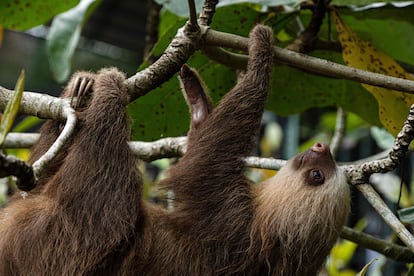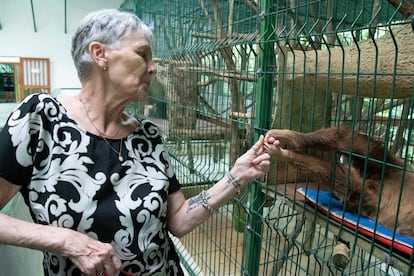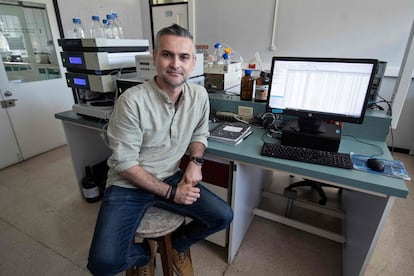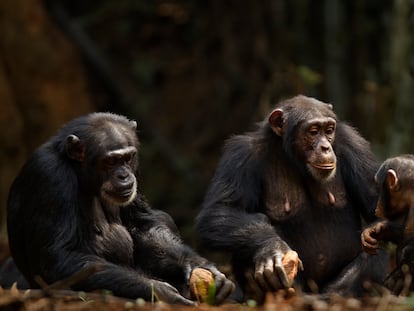Costa Rica researchers discover potential for human antibiotic applications in sloth fur
The mammal’s abundant hair houses a world of living beings that balance each other out, opening up potential responses to pathogens that are harmful to humans

It is rare for an animal native to the hot, humid jungles of Central and South America to be so hairy. It is also strange that a species with so many similarities to monkeys is closer in familial terms to the armadillo: as strange as it is that this wild mammal, which appears in so many tourist photographs, was formally named a national symbol by Costa Rica in 2021. It is also unusual that so many creatures inhabit the micro-cracked, sometimes green fur of one of the friendliest animals in the forest: the sloth bear (which despite its name, is not even a bear).
It has now come to light that the peculiarities of this animal, which weighs less than 10 kilograms (22 pounds) and spends most of its life in the trees, go beyond naturalist or tourist interest. The fields of chemistry and medicine have a lot of work ahead with sloths after researchers at the University of Costa Rica (UCR) discovered bacteria in their fur with the potential to produce antibiotics for human benefit. The study was undertaken due to questions over how the small but rich ecosystem existing in the fur of sloths manages to balance itself out to prevent fungi from taking hold and making the animals sick.

An “ecosystem full of organisms, including moths and insects”
The research is far from being concluded, but it appears to be on the right path. In 2022, the presence of the bacteria in two- and three-toed sloths was proven by research published in the scientific journal Environmental Microbiology, which aroused the interest of French researchers who are now collaborating with UCR scientists in the initial phase: identifying these molecules, comparing them with other antibiotics and testing their usefulness against pathogens that are harmful to humans.
This work is being carried out at UCR laboratories in San José, some 200 kilometers (124 miles) from the refuge for sloths where the hair samples were extracted, in Cahuita de Limón, where specimens can be found daily in the forest or crossing streets using cables for public lighting. Many of the animals that arrive at the shelter have been injured, by traffic for example, but appear to be protected from pathogens.
Max Chavarría, the coordinator of the study and an expert in microbial biotechnology from the UCR’s Natural Products Research Center and the National Center for Biotechnological Innovations, explains: “In principle we wanted to analyze exotic environments that have not been studied, environments to which not everyone has access and that make the work attractive. The sloth’s fur is not like that of a teddy bear, it’s a whole ecosystem full of organisms, including moths and insects. That led us to think that such a complex ecosystem surely has systems that help control the proliferation of other living organisms that can make the animal sick. What keeps the animal from getting sick? Based on a hypothesis of beneficial bacteria, we decided to start this project and look for bacteria there. And the hypothesis was fulfilled, because we found bacteria with the capacity to produce antibiotics.”

Analyses conducted at Costa Rica’s National Nanotechnology Laboratory indicated that the theory of the presence of these bacteria, which produce substances to disarm others that sloth bears host, was correct. The animal’s unique fur allows it to conserve a lot of moisture and therefore provide a home for a variety of living organisms, including algae that allow sloths to mimic the green color of tree leaves, a protection service from predators provided in exchange for the nutrients consumed by these organisms, as other studies have shown.
However, there is still much that remains unknown about the relationships between the organisms that travel aboard the famously slow animal that always seems to be wearing a pleasant smile, despite the vulnerability of the species through the destruction of its natural habitat and illegal trafficking.
Two of the six species of sloth were declared national symbols by the Legislative Assembly of Costa Rica in 2021, based on their iconic value in the Central American country’s ecotourism market. The law mandates the development of awareness and education campaigns on the preservation of these animals and the promotion of scientific research, such as the one being carried out Chavarría and his UCR team which, despite its limited resources, had the research published in the journal Enviromental Microbiology.
“There is still a lot to do. We are in a phase that presents a difficulty; that of seeing the antibiotic molecules, then comparing them with those that are already known and continuing the research, with the possibility of even patenting them. In a favorable scenario, then we will test antibiotic activity in different models and rule out the possibility that they can cause any harm to humans,” says Chavarría, who is optimistic about the work of the “100% Costa Rican” team, but also about growing international interest in the project.
Sign up for our weekly newsletter to get more English-language news coverage from EL PAÍS USA Edition
Tu suscripción se está usando en otro dispositivo
¿Quieres añadir otro usuario a tu suscripción?
Si continúas leyendo en este dispositivo, no se podrá leer en el otro.
FlechaTu suscripción se está usando en otro dispositivo y solo puedes acceder a EL PAÍS desde un dispositivo a la vez.
Si quieres compartir tu cuenta, cambia tu suscripción a la modalidad Premium, así podrás añadir otro usuario. Cada uno accederá con su propia cuenta de email, lo que os permitirá personalizar vuestra experiencia en EL PAÍS.
¿Tienes una suscripción de empresa? Accede aquí para contratar más cuentas.
En el caso de no saber quién está usando tu cuenta, te recomendamos cambiar tu contraseña aquí.
Si decides continuar compartiendo tu cuenta, este mensaje se mostrará en tu dispositivo y en el de la otra persona que está usando tu cuenta de forma indefinida, afectando a tu experiencia de lectura. Puedes consultar aquí los términos y condiciones de la suscripción digital.
More information
Archived In
Últimas noticias
Maduro pleads not guilty before the federal court in New York: ‘I am still the president of Venezuela’
A new test can detect Alzheimer’s from a finger prick
UN team enters Sudanese city of El Fasher after paramilitary massacre: ‘It’s like a ghost town’
A recipe for resistance: Indigenous peoples politicize their struggles from the kitchen
Most viewed
- Gilles Lipovetsky: ‘If you want to live better and fall in love, take Prozac, don’t look to philosophy’
- Alain Aspect, Nobel laureate in physics: ‘Einstein was so smart that he would have had to recognize quantum entanglement’
- Alvin Hellerstein, a 92-year-old judge appointed by Bill Clinton, to preside over Maduro’s trial in New York
- Maduro’s downfall puts China’s relationship with Venezuela to the test
- Why oil has been at the center of Venezuela-US conflicts for decades










































